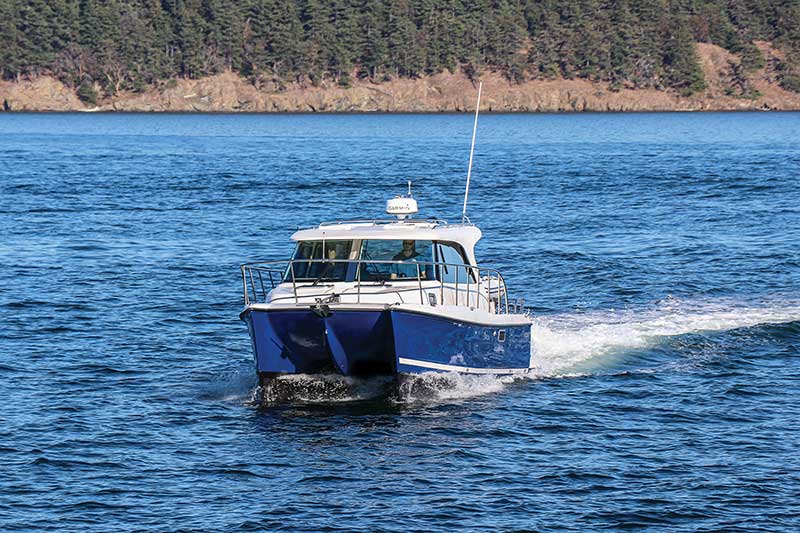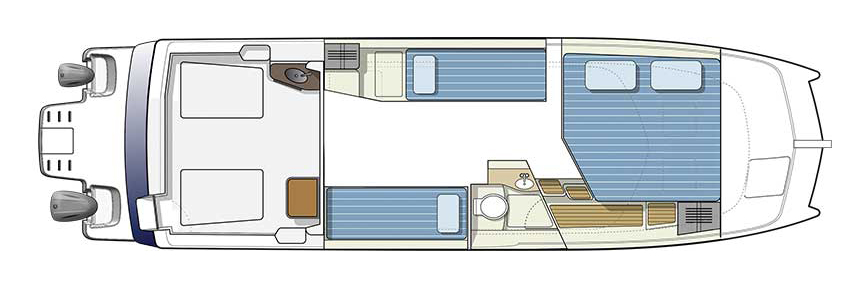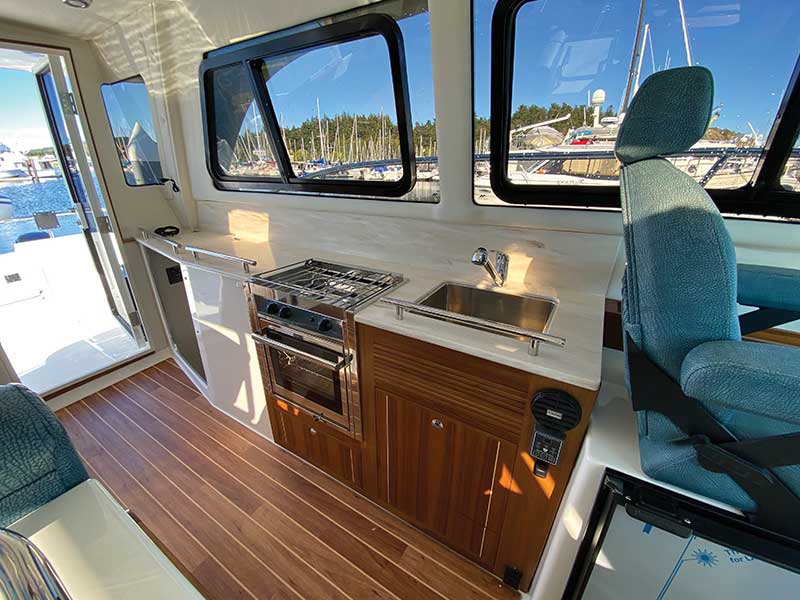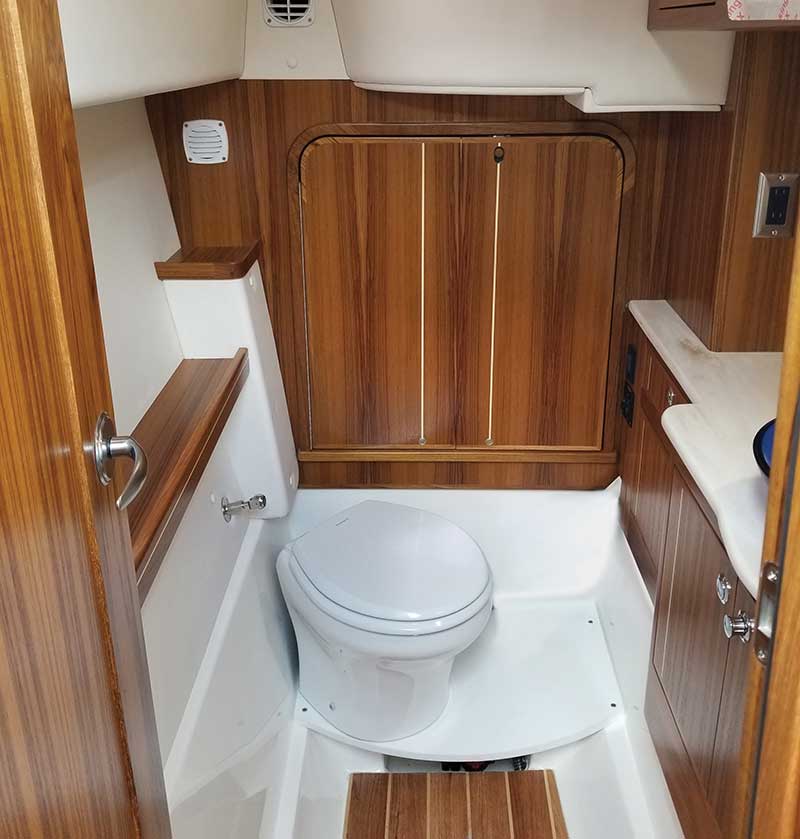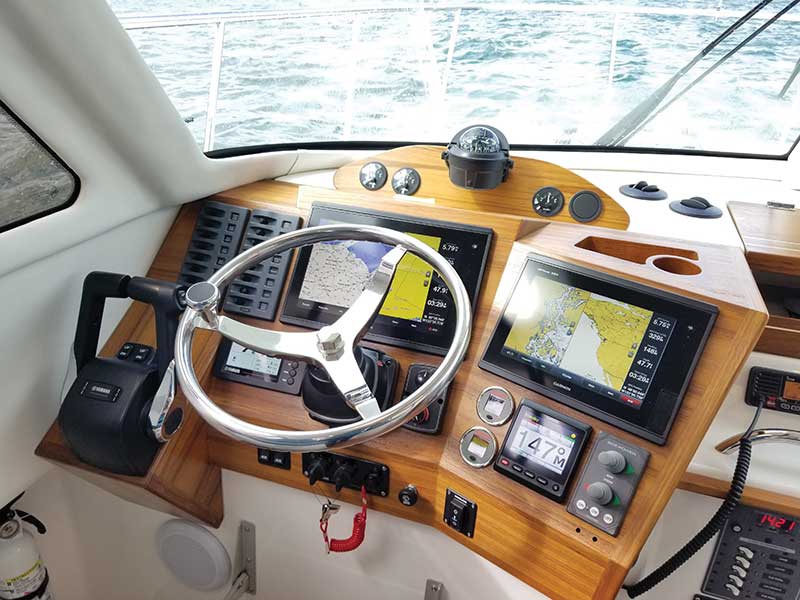Dare to be different.
by Capt. Arnie Hammerman
Aspen Power Catamarans builds a unique form of PROA power cat.
Larry Graf, former founder of Glacier Bay, started Aspen in 2008 because he knew he could build a better boat with a new efficient design. Aspens are different, which made me wonder at first, but Graf’s enthusiasm and knowledge encouraged me to investigate further. Seeing and driving Aspens helped me realize that their differences are really strengths. The new Aspen C108 is both efficient and versatile, hosting abundant accommodations for cruising and entertaining, as well as a stable platform for fishing and the added convenience of trailerability.
Asymmetry
The Aspen concept is simple: One hull is 35% thinner than the other. Both hulls are the same length and have a similar profile so you cannot tell just by looking at the boat. What purpose do asymmetrical hulls serve? Primarily it’s about efficiency and speed. The smaller hull has less water resistance, allowing the boat to be pushed through the water more easily. Less resistance means better fuel economy and higher speeds for any given horsepower.
 The first Aspens were powered by a single diesel inboard. A single engine off to one side seems like it would affect handling, but the hydrodynamics of both hulls are designed to make the boats track straight. Aspen still builds diesel-powered boats and now also produces gasoline outboard models, like our test boat, the C108.
The first Aspens were powered by a single diesel inboard. A single engine off to one side seems like it would affect handling, but the hydrodynamics of both hulls are designed to make the boats track straight. Aspen still builds diesel-powered boats and now also produces gasoline outboard models, like our test boat, the C108.
When developing the outboard boats, Graf was interested in adding a trolling motor. Careful testing showed that having the smaller outboard lowered in the water improved tracking. Since both outboards are in the water, it makes sense to power them both while running. It looks unusual, but outboard-powered Aspens have two different motors, each sized to match the asymmetrical hulls. The Aspen C108 uses both a 115- and a 200-hp Yamaha that have the same gear ratio and prop pitch, which means they operate at the same RPM, so the boat accelerates smoothly and evenly. Aspen hulls do not plane; the narrow entry of the hulls and low wetted surface allow them to go fast even though they displace water. Because the hulls cut through the water, they don’t create much wake even at high speeds.
Throttle Forward
Seated in one of two identical Bentley helm seats on the C108, I ease the throttles forward, which produces little bow rise, and visibility remains excellent. The boat simply accelerates smoothly and easily to the RPM I choose. There is no “hump” to push over and, because of this, the boat can be run at any selected speed. While testing, fuel burn remained steady at 2.3 mpg between 2500 and 3500 RPM with speed ranging from 11-18 mph. This means there is little fuel penalty for running at 18 mph/3500 RPM, creating a sweet spot that gives the boat a range of 380 miles. The numbers are notably consistent at any speed, even in the mid-ranges that many outboard boats have trouble with. An impressive top speed of 30 mph yields 1 mpg, giving the boat a range of 162 miles even wide open.
The twin hulls keep the boat remarkably stable and provide an extremely smooth ride. In a tight 25 mph turn, the boat does not slip or cavitate and barely produces a wake. When heading straight, the boat tracks perfectly even with hands off the wheel. A Garmin electronics package with autopilot is an option but was not needed. To simulate seas, I turn hard and head through our wake, but there is nothing to hit. When another boat cruises by, I head for the wake, jet ski-style. The Aspen simply cuts quietly through and emerges on the other side with no fuss or drama. The curved, tempered windshield with Pantograph wipers remains dry throughout our maneuvers due in part to the high contoured catamaran tunnel that does not slap like some cats.
From speed I cut the power to neutral and the boat glides for a bit, demonstrating the slipperiness of the hulls. The C108 comes with a Side Power electric bow thruster and we have an optional stern thruster, both of which are on the starboard hull and positioned so they don’t push against the opposite hull. A precise amount of buoyancy is even added when mounting the stern thruster to compensate for the slight addition of weight aft. The thrusters work well and are convenient for dockside maneuvering but the boat spins easily using just the engines too.
“My background is in physics and engineering. My training led me to catamarans, and when I saw the PROA design of the Aspen I was impressed,” says Michael H., the owner of Aspen C108 hull No. 1. “Then I met Larry [Graf] and his family, and their dedication to the quality of construction and the level of organization at the factory sealed the deal.”
Built Tough
Graf is an adventurer, having cruised many miles of open water, so he builds Aspens strong enough so that they can handle the unexpected.
“After a trip where weather came up fast and blew 60 knots in the Straights of Mackinaw, I developed a deep respect for the Great Lakes,” Graf says. “I build our boats tough, and they need to be when cruising this area.”
Aspens have double bottom hulls with the added protection of Kevlar-reinforced bow stems. The hulls are built with pure vinyl ester resins and ISO polyester resins with fiberglass roving; the glass fibers go the entire length of hull and up and down the hull sides for increased rigidity and strength. Quality construction materials, like Coosa board instead of wood and Armorcoat gelcoat, are all used in Aspen’s Burlington, Washington, factory.
The C108 has a beam of 10 feet, 8 inches, which is similar to or less than comparable 35-foot monohulls, meaning it can fit in most standard slips. The C108 is also trailerable so owners can haul the boat out themselves for the winter — or even better, take the boat south. The boat can be towed with a ¾-ton or larger pickup truck on the optional aluminum trailer.
The C108 features three separate cabins, including a master stateroom with a king-size bed, plenty of storage and a bookshelf with lights. Quality Burmese teak is used throughout the interior. The salon is surrounded by solar guard windows that keep the cabin light and airy while providing insulation. Opening hatches, windows and doors can bring in summer breezes, and heat and/or air conditioning are options. The galley has a tile backsplash over Corian counters, a deep stainless sink, Force 10 propane stove/oven, Nova Kool fridge and abundant storage featuring teak drawers. The Duratec-coated teak dining table around the spacious U-shaped lounge is gimballed to swing out for easy access and the seats recline. A pop-up window connects to the cockpit above a teak cocktail ledge, which features twin cushion-top stainless bar stools that pivot. A nice touch is that one of these bar stools can be pulled out and placed in an additional socket at the salon lounge, creating an extra seat at the table.
If you dare to be different, the Aspen C108 delivers in many ways. You may find yourself explaining at the dock why your boat has two different engines on it, but once you’re underway, cruising fast and efficiently with all the comforts of home, no explanation will be necessary.

Smooth, stable & efficient ride
King-size master bed
Three cabins in a 35-foot boat
Dinghy rack stows dinghy over outboards

Starboard twin cabin access is through the head
A door on the master cabin would be nice
Head is very large but lacks a separate shower compartment
Specifications
- LOA: 37’6″
- Beam: 10’8″
- Weight: 10,840 lbs.
- Fuel Capacity: std. 130 gals. / opt. 180 gals.
- Water Capacity: 50 gals.
- Power: Yamaha 200-hp (starboard) & 115-hp (port)
- MSRP: $398,000
- Website: aspenpowercatamarans.com
Dealers
- Aspen Power Catamarans
info@aspenpowercatamarans.com
Photo Courtesy of Aspen
Photo Courtesy of Aspen
Photo Courtesy of Aspen
Photo Courtesy of Aspen
Photo Courtesy of Aspen


